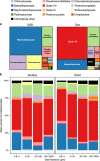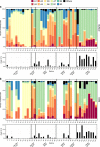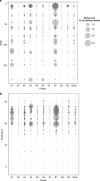Diversity and oceanic distribution of prasinophytes clade VII, the dominant group of green algae in oceanic waters
- PMID: 27779617
- PMCID: PMC5270561
- DOI: 10.1038/ismej.2016.120
Diversity and oceanic distribution of prasinophytes clade VII, the dominant group of green algae in oceanic waters
Abstract
Prasinophytes clade VII is a group of pico/nano-planktonic green algae (division Chlorophyta) for which numerous ribosomal RNA (rRNA) sequences have been retrieved from the marine environment in the last 15 years. A large number of strains have also been isolated but have not yet received a formal taxonomic description. A phylogenetic analysis of available strains using both the nuclear 18S and plastidial 16S rRNA genes demonstrates that this group composes at least 10 different clades: A1-A7 and B1-B3. Analysis of sequences from the variable V9 region of the 18S rRNA gene collected during the Tara Oceans expedition and in the frame of the Ocean Sampling Day consortium reveal that clade VII is the dominant Chlorophyta group in oceanic waters, replacing Mamiellophyceae, which have this role in coastal waters. At some location, prasinophytes clade VII can even be the dominant photosynthetic eukaryote representing up to 80% of photosynthetic metabarcodes overall. B1 and A4 are the overall dominant clades and different clades seem to occupy distinct niches, for example, A6 is dominant in surface Mediterranean Sea waters, whereas A4 extend to high temperate latitudes. Our work demonstrates that prasinophytes clade VII constitute a highly diversified group, which is a key component of phytoplankton in open oceanic waters but has been neglected in the conceptualization of marine microbial diversity and carbon cycle.
Figures

 ). Empty dot (○) represents a node supported by only one method, either ML or Bayes.
). Empty dot (○) represents a node supported by only one method, either ML or Bayes.




Similar articles
-
Comparison of coastal phytoplankton composition estimated from the V4 and V9 regions of the 18S rRNA gene with a focus on photosynthetic groups and especially Chlorophyta.Environ Microbiol. 2018 Feb;20(2):506-520. doi: 10.1111/1462-2920.13952. Epub 2017 Nov 3. Environ Microbiol. 2018. PMID: 28984410
-
Photosynthetic pigments of oceanic Chlorophyta belonging to prasinophytes clade VII.J Phycol. 2016 Feb;52(1):148-55. doi: 10.1111/jpy.12376. Epub 2016 Jan 19. J Phycol. 2016. PMID: 26987097
-
Diversity and oceanic distribution of the Parmales (Bolidophyceae), a picoplanktonic group closely related to diatoms.ISME J. 2016 Oct;10(10):2419-34. doi: 10.1038/ismej.2016.38. Epub 2016 Mar 22. ISME J. 2016. PMID: 27003244 Free PMC article.
-
Genome diversity in the smallest marine photosynthetic eukaryotes.Res Microbiol. 2011 Jul-Aug;162(6):570-7. doi: 10.1016/j.resmic.2011.04.005. Epub 2011 Apr 21. Res Microbiol. 2011. PMID: 21540104 Review.
-
Unveiling new microbial eukaryotes in the surface ocean.Curr Opin Microbiol. 2008 Jun;11(3):213-8. doi: 10.1016/j.mib.2008.04.004. Epub 2008 Jun 13. Curr Opin Microbiol. 2008. PMID: 18556239 Review.
Cited by
-
Diversity and genomics of giant viruses in the North Pacific Subtropical Gyre.Front Microbiol. 2022 Nov 25;13:1021923. doi: 10.3389/fmicb.2022.1021923. eCollection 2022. Front Microbiol. 2022. PMID: 36504832 Free PMC article.
-
Algal photosynthesis converts nitric oxide into nitrous oxide.Proc Natl Acad Sci U S A. 2020 Feb 4;117(5):2704-2709. doi: 10.1073/pnas.1915276117. Epub 2020 Jan 15. Proc Natl Acad Sci U S A. 2020. PMID: 31941711 Free PMC article.
-
Transcriptome reconstruction and functional analysis of eukaryotic marine plankton communities via high-throughput metagenomics and metatranscriptomics.Genome Res. 2020 Apr;30(4):647-659. doi: 10.1101/gr.253070.119. Epub 2020 Mar 23. Genome Res. 2020. PMID: 32205368 Free PMC article.
-
Microbial planktonic communities in the Red Sea: high levels of spatial and temporal variability shaped by nutrient availability and turbulence.Sci Rep. 2017 Jul 26;7(1):6611. doi: 10.1038/s41598-017-06928-z. Sci Rep. 2017. PMID: 28747798 Free PMC article.
-
Green microalgae in marine coastal waters: The Ocean Sampling Day (OSD) dataset.Sci Rep. 2018 Sep 19;8(1):14020. doi: 10.1038/s41598-018-32338-w. Sci Rep. 2018. PMID: 30232358 Free PMC article.
References
-
- Amacher J, Neuer S, Anderson I, Massana R. (2009). Molecular approach to determine contributions of the protist community to particle flux. Deep Sea Res Part I Oceanogr Res Pap 56: 2206–2215.
-
- Béranger K, Mortier L, Crépon M. (2005). Seasonal variability of water transport through the Straits of Gibraltar, Sicily and Corsica, derived from a high-resolution model of the Mediterranean circulation. Prog Oceanogr 66: 341–364.
-
- Cachon M, Caram B. (1979). A symbiotic green alga, Pedinomonas symbiotica sp. nov. (Prasinophyceae), in the radiolarian Thalassolampe margarodes. Phycologia 18: 177–184.
MeSH terms
Substances
LinkOut - more resources
Full Text Sources
Other Literature Sources

